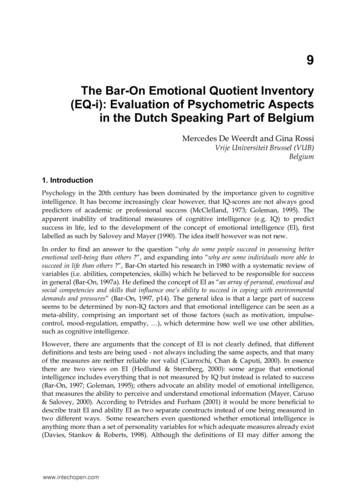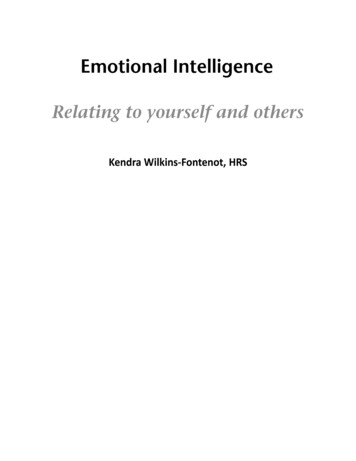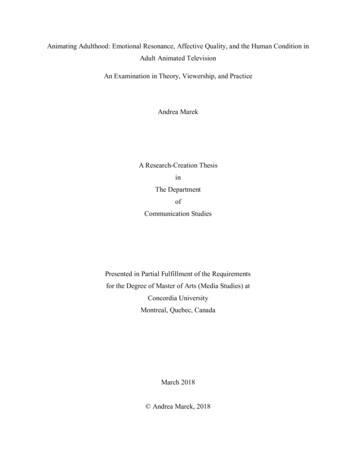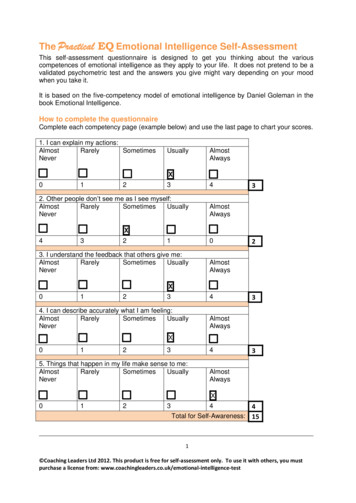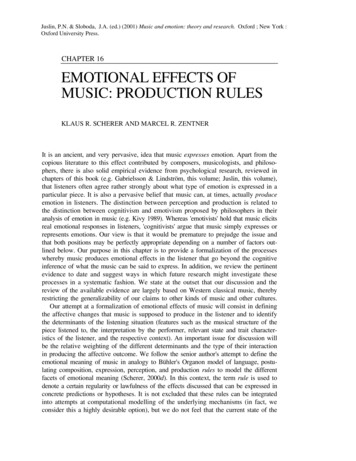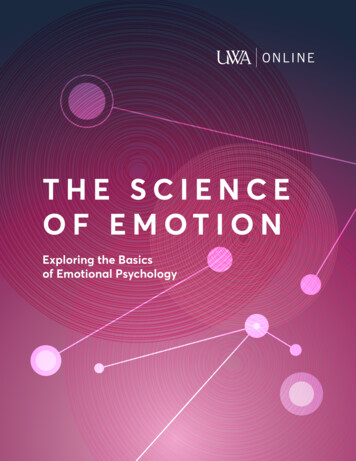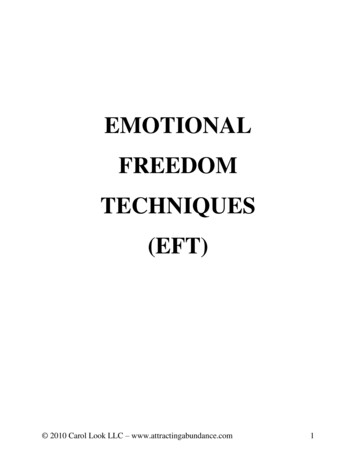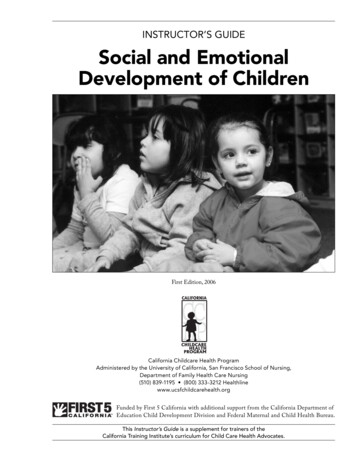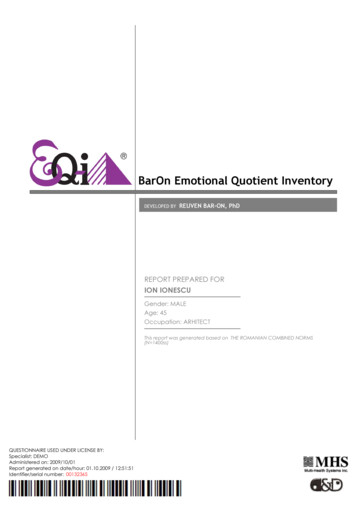
Transcription
BarOn Emotional Quotient InventoryDEVELOPED BYREUVEN BAR-ON, PhDREPORT PREPARED FORION IONESCUGender: MALEAge: 45Occupation: ARHITECTThis report was generated based on THE ROMANIAN COMBINED NORMS(N 1400ss)QUESTIONNAIRE USED UNDER LICENSE BY:Specialist: DEMOAdministered on: 2009/10/01Report generated on date/hour: 01.10.2009 / 12:51:51Identifier/serial number: 00132365
EMOTIONAL QUOTIENT INVENTORYReuven Bar-On, PhDINTERPRETING OF THIS REPORTPURPOSEDEFINITIONThis report helps in the better understanding of those preferential, attitudinal and behavioralcharacteristics of the evaluated persons, which are related to emotional intelligence.Emotional intelligence is defined by the author of the test as ''an array of noncognitivecapabilities, competencies, and skills that influence one's ability to succeed in coping withenvironmental demands and pressures''.Many studies have stressed the importance of emotional intelligence for personal success.Emotional intelligence is one of the factors that determine one person's ability to succeed incoping with environmental demands, combining with other important factors, such as biomedicalpredispositions and conditions, cognitive intellectual capacity, as well as the reality andlimitations of the immediate and ever-changing environment. Emotional intelligence also directlyinfluences one's general psychological well-being, that is one's present condition of overalldegree of emotional health.USAGEThis report has been generated for the use of psychologists, counseling staff and other types ofspecialized professionals, in their work with clients.Although formulated as a stand-alone report, which especially in the second section (detailedreport) may also be easily understood by persons not trained in the usage of psychological tests,this report has been projected and developed in such a way as to offer assistance to theprofessional who is interpreting the test results.These results should only be considered in conjunction with professional judgment, after acareful and detailed analysis, and only after corroborating these data with the results of aninterview and of other possible psychometric instruments. Results contained in this report maybe subject to alterations and special highlights as a function of such corroborations made by aspecialized professional.FUNDAMENTThis report is based on the EQ-i, a psychometric instrument that has been validated in a widevariety of research programs in a large number of countris all around the world. The EQ-i is astructured, verbal, omnibus measure of emotional intelligence. The questionnaire consists of 133items, grouped in 17 scales (two of them validational), and 5 composite scales. The EQ-i providesscores for each of them, providing also a global emotional quotient index. The EQ-i is based onthe Bar-On model of social-emotional intelligence, which has been developed by the author ofthe test, and whose conception states that emotional intelligence consists of five meta-factors:Intrapersonal, Interpersonal, Stress Management, Adaptability and General Mood.WHAT INFORMATION DOES THIS REPORT INCLUDE?STRUCTUREIn addition to the introductory section, the report contains three main sections:1.2.3.4.TheTheTheTheEQ-i profile,Detailed Report,Interpretive Report,'Modus Operandi' Details.1. The EQ-i ProfileCHARTSSTANDARD SCORESThis section contains three charts: the chart for the global emotional quotient, the chart for thescores of the five composite scales and the chart for the scores of the fifteen structural scales.All the scores are presented in T scores. The charts are accompanied by the numerical processingof the scores and by the indication of the meaning of the group in which are situated the scores:consider development, efficient functioning, and enhanced functioning.The EQ-i scores are represented in T scores. The T scores are standardized scores,transformations of the raw scores, based on the mean and the standard deviation of thenormative sample used for scoring the test. The purpose of standardizing in T scores the EQ-iscores is that of standardizing the measurement, so that for each scale the mean is 100 and thestandard deviation is 15. The standardized scores have been computed on the basis of theRomanian normative sample, formed by N 1400 persons (700 females and 700 males).1
EMOTIONAL QUOTIENT INVENTORYReuven Bar-On, PhDVALIDITYINDICATORSThe Profile section also contains technical details about the validity indicators of the EQ-i and areport on the statistical corrections made to every one of the scales, as a result of scoresobtained on these validity indicators.2. The EQ-i detailed reportPURPOSEThe detailed report offers a drilldown of the emotional intelligence characteristics ascertainedthrough the EQ-i and charted in the EQ-i profile, in the previous section. The data presented inthis section is based on the Romanian combined normative sample.This section has been developed by psychologists in such a way as to offer assistance to theprofessionals who interpret the results and to minimize their reverting to the test manual, butmay also be read by the evaluated person as part of a structured discussion with the psychologistor as part of a personal development program the evaluated person is part of. However, theconclusions of this report should only be considered after discussing them with a specializedprofessional.MEANINGThe detailed section contains for each of the 15 scales and 5 composite scales of the EQ-i, aswell as for the global emotional quotient, a chart based on the standardized T scores obtained bythe evaluated person. Also, below every chart one can read a definition of the scale, as well asthe meaning of the high and low scores for the scale. These meanings of the high and low scoresare the more characteristic for the evaluated persons as they are closer to the high andrespectively low scores.Generally, enhanced scores represent a good development of the ability pictured by the name ofthe scale. The scores around the mean indicate a satisfactory functioning of the respectiveability and are characteristic for most of the test-takers. Low scores indicate areas that needfurther development in order to contribute to the enhancement of the emotional and socialintelligence of the evaluated person. Among the high and low scores one may identify specialstrengths and weaknesses.3. The EQ-i interpretive reportPURPOSEThe EQ-i interpretive report offers a verbatim description of the evaluated person's results on thequestionnaire. Results are interpreted verbally, not visually, giving an account which is easilyread and understood and which is a good basis for a feedback session.Users should always bear in mind the fact that the interpretive report is a computer-generatedreport and as such is meant to act as an interpretive aid. It should never be used as the singlebasis for placement, intervention, or other kinds of decision making. The report works bestcombined with other sources of relevant information and should be validated by a professionalspecialized in the usage of the EQ-i.4. The ''Modus Operandi'' detailsITEMMETRICSTATISTICSThe modus operandi statistics offer a summary of the way in which the questionnaire has beenapproached by the test-taker. It focuses on the validity scores, the scale corrections and theanswers to the items.2
3EMOTIONAL QUOTIENT INVENTORYReuven Bar-On, PhD1SECTION 1: THE EQ-I PROFILETOTAL EQ CHARTEMOTIONAL 0150935060708090Area for improvementEffective functioningEnhanced skillsCOMPOSITE SCALESCHART OFCOMPOSITE 00Intrapersonal (RA)Interpersonal (ER)94Stress Management (SM)9487Adaptability (AD)91General Mood (GM)50607080Area for improvement90100EffectivefunctioningEnhanced skills
4EMOTIONAL QUOTIENT INVENTORYReuven Bar-On, PhDCONTENT SCALES50CHART OFCONTENT ersonal (RA)Self-Regard (SR)97Emotional Self-Awareness (ES)98108Assertiveness (AS)102Independence (IN)100Self-Actualization (SA)Interpersonal (ER)104Empathy (EM)99Social Responsibility (RE)84Interpersonal Relationship (IR)Stress Management (SM)100Stress Tolerance (ST)89Impulse Control (IC)Adaptability (AD)84Reality Testing (RT)75Flexibility (FL)104Problem Solving (PS)General Mood (GM)98Optimism (OP)86Happiness (HA)50607080Area for improvement90100Effectivefunctioning110Enhanced skills
5EMOTIONAL QUOTIENT INVENTORYReuven Bar-On, PhDVALIDITY INDICATORSValidity Comment:The validity indicators are all in the acceptable range suggesting valid responses andresults that are not unduly influenced by response style.Inconsistency Index:Impression Management:Corrections:II 4Positive Impression (PI) 117Negative Impression (NI) 101Type 1 -3.09, Type 2 -4.11, Type 3 -3.00, Type 4 -4.03,Type 5 -3.38Positive Impression (PI) and Negative Impression (NI) ScoresThe score on the Positive Impression scale (PI) was somewhat elevated. Although the PI scoreindicates a tendency towards overly positive self-presentation, the tendency was small andshould not have a major influence on the results and interpretation of the scores.Correction Factors:The correction factors are used to fine tune EQ-i scores on the basis of validity scale scores.The adjusted (or corrected) scores take into account response style. Corrections of greaterthan zero mean that points have been added to the scores, and corrections less than zeromean that points have been taken off the scores. Because EQ-i scales are affected differentlyby response tendencies, different types of corrections are applied as follows:Type I applies to Total Intrapersonal, Emotional Self-Awareness, Problem Solving, and Flexibility.Type II applies to Total EQ, Total Adaptability, Reality Testing, and Stress Tolerance.Type III applies to Social Responsibility, Happiness and Impulse Control.Type IV applies to Total Stress Management, Total General Mood, and Self-Regard.Type V applies to Total Interpersonal, Interpersonal Relationship, Optimism, and Self-Actualization.There is no correction for Independence, Empathy, and Assertiveness.Inconsistency IndexThe responses to items with similar content are consistent with one another.
6EMOTIONAL QUOTIENT INVENTORYReuven Bar-On, PhDADJUSTMENTS TO SCALE AND SUBSCALE SCORESAdjusted scoreUnadjusted scoreCommentsInconsistency Index (II)4.00OKPositive Impression (PI)117.14HighNegative Impression (NI)100.62AverageEMOTIONAL QUOTIENT (EQ)93.3297.44AverageINTRAPERSONAL (RA)99.95103.04AverageSelf-Regard (SR)97.44101.47AverageEmotional Self-Awareness (ES)97.93101.01AverageAssertiveness (AS)108.21108.21AverageIndependence (IN)102.29102.29AverageSelf-Actualization (SA)99.83103.21AverageINTERPERSONAL (ER)93.7297.10AverageEmpathy (EM)103.63103.63AverageSocial Responsibility (RE)98.93101.93AverageInterpersonal Relationship (IR)84.0587.43AverageSTRESS MANAGEMENT (SM)93.7797.80AverageStress Tolerance (ST)100.16104.27AverageImpulse Control (IC)88.8991.89AverageADAPTABILITY (AD)86.5090.62AverageReality Testing (RT)83.5387.64AverageFlexibility (FL)74.7777.85Low103.98107.07AverageGeneral Mood (GM)90.8594.88AverageOptimism (OP)97.77101.15AverageHappiness (HA)86.0189.01AveragePROBLEM SOLVING (PS)
7EMOTIONAL QUOTIENT INVENTORYReuven Bar-On, PhD2SECTION 2: THE DETAILED REPORT* For the optimal use of this detailed report, we recommend that you take the descriptioncontained in the introductory text of this file into account. The information contained in thisdetailed section does not represent an interpretation of the test, but a mere aid in thisinterpretation, which has to be made by a professional trained in the usage of this test.** This profile is based on the EQ-i technical manual - BarOn, R. (1996). BarOn Emotional QuotientInventory. Toronto: Multi-Health Systems Inc. - and on the computerized reports of the US versionof the test.TOTAL EQ SCALEDESCRIPTIONEQ: EMOTIONAL QUOTIENTSTANDARD SCORE 93.32 (RAW SCORE 935060Markedly Low7080Very Low90LowAverageHighVery HighMarkedly highTotal EQ indicates the effective emotional and social functioning overall, that is the degree towhich the person has an array of noncognitive capabilities and skills that he/she makes use ofsuccessfully in coping with environmental demands and pressures.A low score is characteristic to persons with littlenon cognitive capacities and skills that they can usein adapting to environment. These persons generallyhave a more pessimistic outlook on life and a lowercontrol of emotions.A high total emotional quotient means that theevaluated person feels good about himself/herselfand others and has a fulfilled life. A high score ischaracteristic to persons who are generallyoptimistic in front of problems, who have a positiveoutlook of life. They are persons who usuallycontrol their emotions and are not usuallyimpulsive.
8EMOTIONAL QUOTIENT INVENTORYReuven Bar-On, PhDDESCRIPTION OFFACTOR SCALERA: INTRAPERSONALSTANDARD SCORE 99.95 (RAW SCORE 506070Markedly Low80Very Low90Low100AverageHighVery HighMarkedly highThis component of the total Emotional Quotient assesses the inner self, the intrapersonalfunctioning. Its components include Self Regard (SR), Emotional Self Awareness (ES), Assertiveness(AS), Independence (IN), Self Actualization (SA), components that are described in the followingsectionA low score means that the evaluated person has alow self respect, is less in touch with one's feelings,having also difficulties in expressing them, as wellas in defending one's rights in a non destructivemanner. These people are less independent inthinking and action, are not satisfied with realizingthe whole personal potential and not motivated byit.A high score at this component indicates somebodywho is in touch with his/her feelings, feels goodabout himself/herself, and about life
The EQ-i provides scores for each of them, providing also a global emotional quotient index. The EQ-i is based on the Bar-On model of social-emotional intelligence, which has been developed by the author of the test, and whose conception states that emotional intelligence consists of five meta-factors:
